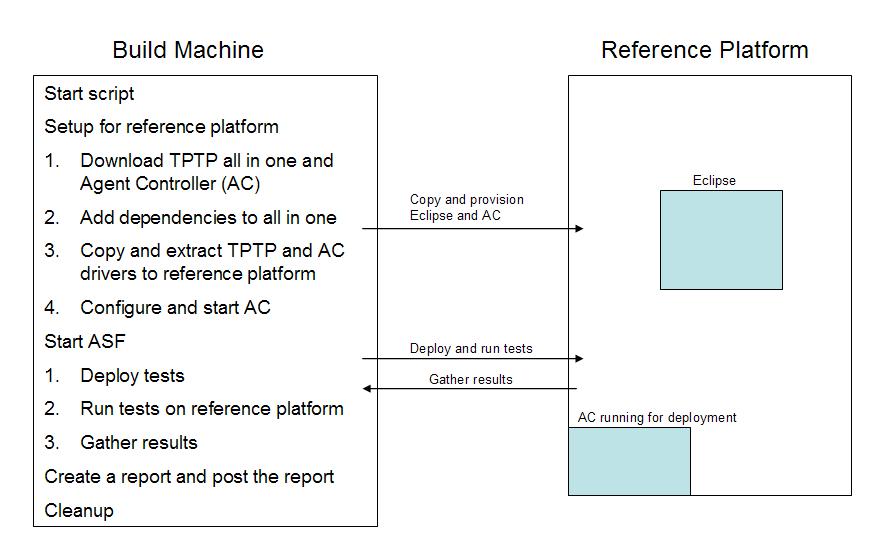Notice: This Wiki is now read only and edits are no longer possible. Please see: https://gitlab.eclipse.org/eclipsefdn/helpdesk/-/wikis/Wiki-shutdown-plan for the plan.
4.5 Test Automation Initiative
Contents
Members
- Paul Slauenwhite (IBM)
- Alan Haggarty (IBM)
- Joel Cayne (IBM)
- Jonathan West (IBM)
- Joanna Kubasta (IBM)
- Kiryl Kazakevich (Intel)
Goals
- Consolidation of our testing process and infrastructure.
- Consolidation of custom test frameworks (Test Dashboard, AC/Profiler test server, variants).
- Reuse of Test Project framework (ASF, reporting, etc.) and tools (AGR, JUnit, etc.).
- Automatic test execution and report generation with every build (BVT).
- Integrate EMMA with the build and test process for generating code coverage reports for all manual and automated testing.
Benefits
- Specialization of testing skills (e.g. builds).
- Provide an infrastructure that makes it easy for committers to contribute automated test cases/suites.
- Manual labor savings by using automated tests, which are automatically executed with every build.
- Decrease time/cost to resolve defects since uncovered earlier in the code-test-build cycle.
- Decrease testing overlap by a) localizing test executing and reporting to one group and b) using code coverage statistics.
Delivery dates
- November 14:
- First draft of the first testing process document for review.
- Proof of concept (PoC) for integration of ASF and TPTP builds for PMC approval and integrate with TPTP builds.
- Status update for the PMC.
- Measure cost savings.
- November 21:
- Review of the first testing process document.
- First draft of the remaining testing process documents for review
- Identify and resolve bugs.
- November 28:
- Final version of the the first testing process document.
- Review of the remaining testing process documents for review
- Status update including cost savings for the PMC.
- Presentation to TPTP committers.
- Each project automates their manual test suites and converge existing automated test suites over time to leverage the test infrastructure.
Testing Process
- Summary:
- A very lightweight testing process for TPTP.
- Extends the existing TPTP Testing Strategy. The existing technical content will remain unchanged, aside from review changes.
- Considered as a instruction manual (e.g. step-by-step) for testing TPTP for each type of testing scenario.
- Sections include
- Getting tests.
- Creating tests.
- Running tests.
- Save test results.
- Reporting results.
- BVTs.
- Two (or more) documents:
- High steps to use the testing infrastructure intended for first time users. This document will reference the other document(s).
- Low level detailed discussion on the motivation and design of the infrastructure intended for TPTP adopters or extenders.
- Additional documents detailing the specifics of a testing topics.
Common Test Infrastructure
- Summary:
- Reference platform:
- Developers are expected to unit test on reference platform before checking-in code to CVS.
- Target: IBM Java 1.5 (latest SR) and Windows XP/x86.
- Goal to expand to a second reference platform for better test coverage (target: Sun Java 5 and Linux/x86).
- IBM JREs for Windows and Linux (see IBM Development Package for Eclipse) are publicly available from developerWorks.
- Once the PoC is complete, Intel will focus on integrating the testing for the native components (e.g. JVMTI profiler) with the test infrastructure.
- ASF integrated with the TPTP builds by invoking the automated tests on reference platform via ANT:
- Invoke tests.
- Interrogate results.
- Generate test reports.
- TPTP test types:
- AGR for functional UI testing.
- TPTP JUnit and TPTP JUnit Plug-in test for unit testing.
- TPTP build infrastructure:
- Extract test suites from CVS.
- Provision reference platform (Agent Controller and Eclipse/TPTP).
- Install and configure Agent Controller and Eclipse/TPTP on the reference platform.
- Clean-up reference platform.
- Post test reports (test and code coverage) on TPTP web site.
- Email notifications to component leads for failing test suites.
- Limitations/Issues:
- Can not test with the Integrated Agent Controller (IAC) since it cannot coexist with the Agent Controller running on the reference platform.
- Intel needs to inform IBM that their portion of the build is complete (see defect 200351).
- Reference platform:
- Architecture: Comments
- Demonstration:
Metrics
In order to evaluate this initiative, are measuring the labor costs (as accurately as possible) in Person Weeks (PW) to run:
- full test pass
- smoke test pass
- Before Initiative:
| Project | Full Test Pass Cost (PW) | Smoke Test Pass Cost (PW) |
|---|---|---|
| Platform | 5 | 2.5 |
| Test | 5 | 2.5 |
| Trace | 3 | 1.5 |
| Monitoring | 3 | 1.5 |
| Total | 16 | 8 |
- With Test Automation:
| Project | Full Test Pass Cost (PW) | Smoke Test Pass Cost (PW) |
|---|---|---|
| Platform | 4 | 2 |
| Test | 4 | 1.5 |
| Trace | 3 | 1.5 |
| Monitoring | 2.5 | 1 |
| Total | 13.5 | 6 |
References
- ASF
- ASF Tutorial
- TPTP Testing Strategy
- Test Dashboard (see enhancement 112928)
- Test Dashboard Plug-in

